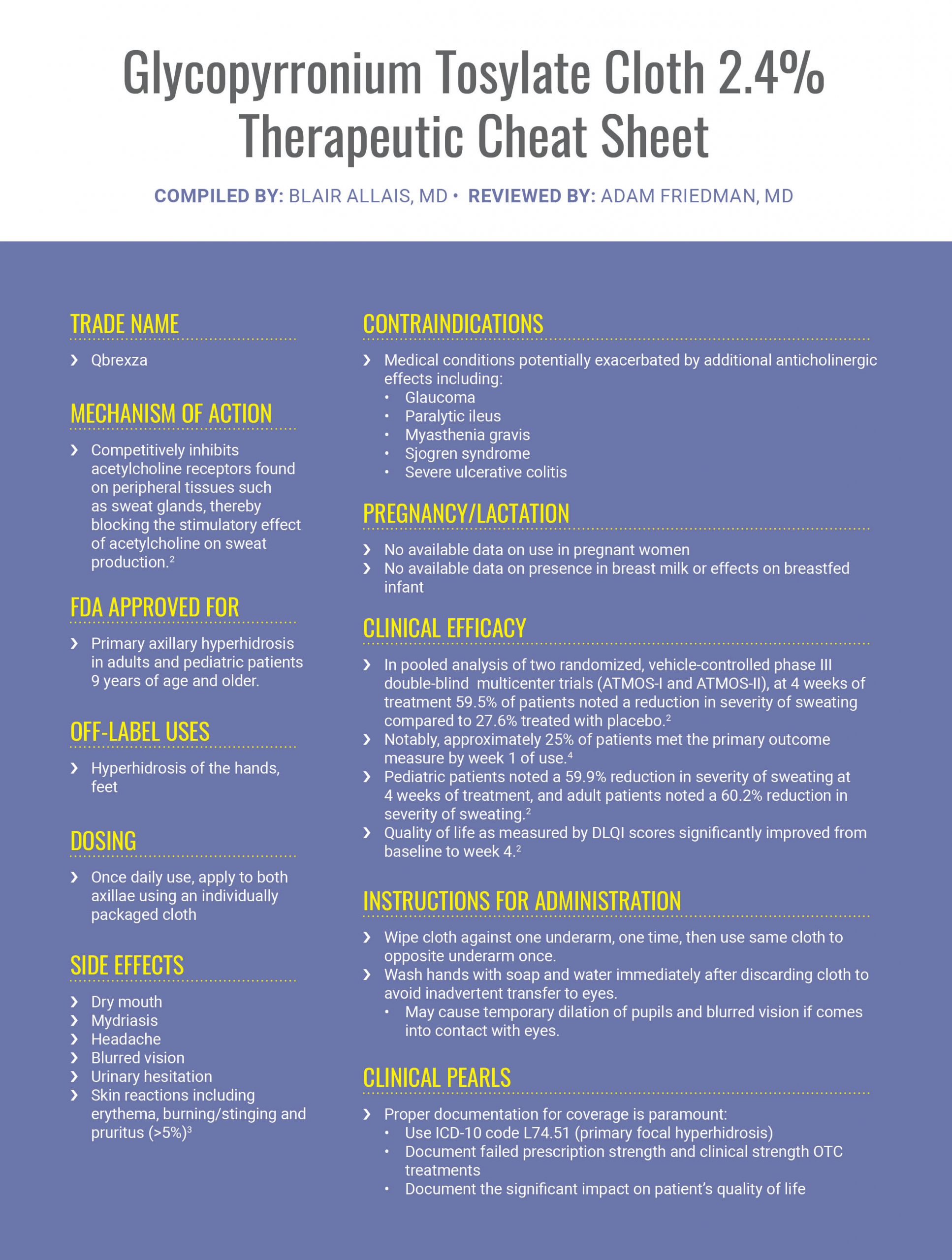Hyperhidrosis affects approximately 4.8% of the U.S. population1 and causes patients significant psychosocial distress. Patients are looking to maximize non-invasive treatment options while avoiding systemic side effects. We continue our series, Therapeutic Cheat Sheet, with a closer look at glycopyrronium tosylate cloths.

Glycopyrronium tosylate cloths are the only approved topical anticholinergic treatment for primary axillary hyperhidrosis and offer a non-invasive, generally well-tolerated treatment option for patients wishing to avoid systemic or invasive treatment.
Further Reading
If you would like to read more about glycopyrronium tosylate cloth, check out the following 2 articles published in the Journals of Drugs in Dermatology:
Variables Affecting Delivery of Glycopyrronium Tosylate Through Human Skin In Vitro
Caserta F, Lenn J, Hofland, H.
ABSTRACT
Background: Hyperhidrosis is a condition characterized by excessive sweating beyond what is required for normal thermal regulation. It can involve multiple body areas including the axillae, palms, soles, or craniofacial regions. Glycopyrronium tosylate (GT) is a topical anticholinergic approved by the FDA (2018) for treatment of primary axillary hyperhidrosis in patients 9 years and older.
Objective: Gain insight into variables (anatomical sites, occlusion, exposure time) affecting GT delivery into human skin.
Methods: Human skin from different anatomical regions (palmar, plantar, axillary, and abdominal skin) was mounted into flow-through diffusion cells (MedFlux-HT®). GT solution (2.4%) was applied at 10 mg/cm2 and the receiving fluid was collected every 2 hours, for 24 hours. GT penetration was determined using LC/MS/MS. The effect of occlusion was assessed by covering the skin with either parafilm or saran wrap, and the effect of exposure time was assessed by incubating the skin for 5, 15, or 60 minutes before washing off the GT from the surface.
Results: GT delivery through palmar and plantar skin was up to 40-fold lower compared to delivery through axillary or abdominal skin. Occlusion increased GT delivery up to 10-fold. Reducing exposure time from 24 hours to either 5, 15, or 60 minutes, decreased GT flux by 90%. However, occlusion during these varied exposure times was able to restore GT delivery to levels found in the 24-hour exposed, non-occluded control group.
Conclusion: These in vitro skin penetration studies showed that skin thickness, exposure time, and occlusion substantially influenced GT delivery, potentially impacting clinical trial design.
J Drugs Dermatol. 2020;19(11): doi:10.36849/JDD.2020.5062
Diagnosis and Management of Primary Hyperhidrosis: Practical Guidance and Current Therapy Update
Gorelick J, Friedman A.
ABSTRACT
Hyperhidrosis is a chronic medical condition characterized by excessive sweating beyond that which is necessary for thermoregulatory homeostasis. It is estimated to occur in 4.8% of the U.S. population (~15.3 million people) but is both underreported and underdiagnosed. With the busy practitioner and dermatology resident in mind, we provide here a disease state primer for hyperhidrosis, a top-line review of the breadth of literature underscoring the overall burden of the disease, a practical guide to differential diagnosis, and an update on current treatment approaches, including for the most common form of the condition, primary axillary hyperhidrosis. In addition, a case study is presented to provide a real-life perspective from the clinic on the importance of early and effective management strategies for those suffering with hyperhidrosis.
J Drugs Dermatol. 2020;19(7): doi:10.36849/JDD.2020.5162
References
-
- Doolittle J, Walker P, Mills T, Thurston J. Hyperhidrosis: an update on prevalence and severity in the United States. Archives of Dermatological Research. 2016;308(10):743-749. doi:10.1007/s00403-016-1697-9.
- Lamb Y. Topical Glycopyrronium Tosylate in Primary Axillary Hyperhidrosis: A Profile of Its Use. Clin Drug. Investig. 2019 Nov;39(11):1141-1147.
- Package insert. Dermira, Inc; 2018.
- Glaser DA, Hebert AA, Nast A et al. Topical glycopyrronium tosylate for the treatment of primary axillary hyperhidrosis: Results from the ATMOS-1 and ATMOS-2 phase 3 randomized controlled trials. J Am Acad Dermatol. 2019 Jan;80(1):128-138.e2.
Did you enjoy this therapeutic cheat sheet? Find more here.

